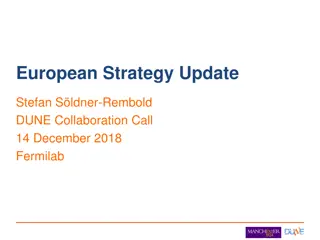SWOSU Technology Optimization Plan
This plan outlines strategic initiatives aimed at optimizing technology to meet the educational and administrative needs of SWOSU. Key focus areas include upgrading identified computers, enhancing technology staffing and support, improving data mining and learning analytics, ensuring satisfaction with online student services, meeting training needs for technology, and reducing software licensing costs. The plan also includes restructuring advisory committees, establishing technology metrics, implementing tiered classroom technology structure, and enhancing technology training systems.
Download Presentation

Please find below an Image/Link to download the presentation.
The content on the website is provided AS IS for your information and personal use only. It may not be sold, licensed, or shared on other websites without obtaining consent from the author.If you encounter any issues during the download, it is possible that the publisher has removed the file from their server.
You are allowed to download the files provided on this website for personal or commercial use, subject to the condition that they are used lawfully. All files are the property of their respective owners.
The content on the website is provided AS IS for your information and personal use only. It may not be sold, licensed, or shared on other websites without obtaining consent from the author.
E N D
Presentation Transcript
Renae Bagzis Guy Biyogmam Rachel Bradley Sherri Brogdon Mark Engelman Denise Landrum-Geyer Kim Liebscher Nicholas Lindley Tami Moser Hardeep Saluja Keith Talley Trisha Wald Jerome Wichert Jonathan Woltz
Original Strategic Initiatives Focus on optimizing technology to meet the educational and administrative needs of SWOSU. 1. A 100%, four year upgrade cycle of identified computers on the Weatherford and Sayre campuses. 2. Increased technology staffing and support on the Weatherford and Sayre campuses. 3. A consistent 90% of all SWOSU administrators and staff satisfied with the ease of data mining and learning analytics at the university.
2. (Contd) 4. 90% of all students satisfied with the online student services they receive at SWOSU. 5. 90% of all faculty, staff, and administrative members are satisfied that their training needs for office technology, classroom technology, and distance learning technology are being effectively met at SWOSU. 6. Reduced software licensing costs for the university without sacrificing operability or functionality and cost savings reallocated to provide financial support for other technology initiatives.
Initial Focus Areas Classrooms Faculty Resources Others (Academic Admin., Library, etc.) Secondary Focus Areas Athletics Auxiliary Bursar Business Office Financial Aid Human resources Recruiting Registrar System
New Strategic Initiatives 1. Re-Structure the make up and charge of the University Computer/Telecommunications Advisory Committee 2. Establish a Tiered Classroom Technology Structure 3. Establish Critical Technology Metrics (ITS, CDeL) 4. Improve Technology Training System
1. Re-Structure the make up and charge of the University Computer/Telecommunications Advisory Committee Original Committee Charge (Fall 2013 Faculty Handbook, pg. 30) Solicits information from SWOSU community concerning present and future technology-related needs and recommends formulation of the technological strategic plan including short and long range acquisition, implementation and coordination of all technology- related activities on a university-wide basis. The committee recommends standards for software, hardware and other related items that will be available university-wide to insure uniformity, accessibility, and economy.
1. Re-Structure the make up and charge of the University Computer/Telecommunications Advisory Committee Goal 6 committee recommendations Clarify reporting relationships and roles and responsibilities Identify staffing gaps and reassign and/or add staff Revise Committee Charge Oversees 3-4 Year Technology Plans and Upgrade Cycle Recommends Long Range Technology Strategy (i.e., BYOD, I-pads, student plug in accessibility, . . . ) Maintain open dialog and feedback from Stakeholders Establish direction and policy recommendations Nota Purchase Order Gatekeeper
University Computer & Telecommunication Executive Committee Members Co-Chairs: Provost - Admin VP ITS Director Library Director CDeL Director Academic Sub-Committee Chair Administrative Sub-Committee Chair Goal 6 Committee Academic Advisory Sub- Committee Members Administrative Advisory Sub-Committee Members Arts & Science (?) Professional & Grad. Studies (?) Pharmacy (?) Sayre (?) Student (?) Library (?) DeLC Chair Business Office/Bursar Registrar - Financial Aid Public Relations Recruitment Sayre ITS Others?
2. Establish a Tiered Classroom Technology Structure Goal 6 committee recommendations Tier One (Minimum) Technology in every classroom Classroom Computer - Ceiling mounted projector w/ speakers - internet access - MS Office - Podium w/ laptop connectivity Tier Two (Customized) Tier One plus additional equipment Such as: Document Camera - Smart Board - Program specific needs, etc. Tier Three (Cutting Edge) Tier Two plus additional equipment Such as: Smart Podium - Student Response System - Mobile Technology Stations Specialized Software - Customized hardware for needs of teachers - Printer, etc.
3. Establish Critical Technology Metrics (ITS, CDeL) Proposed Performance Measures Network/website uptime Installation response time Support (hardware/software) response Others (TBD by ITS, CDeL) More Transparent Communication Make available list of SWOSU classroom technology Make available list of SWOSU software licenses ($ Savings) Provide Installation Target Dates
4. Improve Technology Training System Clarify Training Responsibility for Technology Training (University Computer/ Telecommunications Advisory Committee) Training Coordinator . . . Locates Expertise Foundational vs. Advanced Foundational (LMS, MS Office, Phone, Campus Connect, PX, Classroom Technology, etc.) Advanced (Smart Board, Specialized Software, Web 2.0, Voice Thread, Panopto, Collaborate, etc.) Training Delivery Method (Brown Bag Sessions, Formal Workshops, Others as Needed)
Additional Goal 6 Concerns Succession Management-critical campus technology roles (Executive) Digital Content Strategy - (i.e., Paperless work flow) (Executive) BullDawg Job Board Improvements (Administrative) SWOSU Room Scheduling (Administrative) Mobile Technology Devices Policy. i.e., BYOD (Academic) Social Media Policy and Support (Administrative) Coordinate working tools: Office 365, Dropbox, Google Docs (Executive) WIFI connectivity in all buildings (Administrative)
Next Steps Schedule meeting with the University Computer/ Telecommunications Executive Committee Determine members and schedule of sub- committees Review proposed initiatives discuss action plans Survey Classrooms For Existing Technology Creates a Technology Baseline Needed for Cost Estimates























